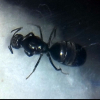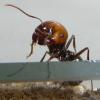Hey guys!
It is with great pleasure that I announce you that finally yesterday I saw my 1st Messor nanitic walking around after all these months since September!
Thanks everyone for helping me keeping my patience and hope since last year my Formica fusca 2 colonies were raided by outside ants and totally devastated.
There's also another queen with 2 already black pupa, so in a few days I hope they come out.
I'm back in business boys!
Since this forum does not have a caring guide for Messors and I'm still too noobie doobie doo to write one (maybe in a couple years?), I looked around previously for information and gathered some notes from a comment from a YouTube video.
I didn't write down the commenter's name, so I don't know who to credit.
So I'm posting you down below the comment I've gathered.
Do you guys think these are good trustworthy guidelines? If nay, please correct them.
Many thanks guys!
when and what to feed the 1st Messor naniticks?
Only give a small amount of seeds when a claustral colony has its first workers or is very close to it with darkened pupae. They workers keep the seeds away from the water cotton just fine, unless you give too much of them. It's wise at this point to attach a small feeding outworld box to the test tube because of all the garbage Messor produces and they can put seeds there if they find the tube too wet or cramped.
People can keep claustral Messor colonies without the need to keep them covered and unchecked. Simply put them in a place with not too bright light with ZERO vibrations (put them on something dampening on a bookshelf or something). No need for even a silly red cover and you can look at them all you want without actually disturbing them. Leaving claustral queens unchecked for long periods is never a good idea (and you do need to give them within about a week when the first workers arive), but the vibrations of uncovering a colony often induces more panic than simply the sudden influx of light.
Seriously, don't give sugar water to Messors. They'll only drink it if they desperately need the moisture. But with all the seed garbage everywhere, even sterile sugar water will generally be quickly found by yeast bacteria and start fermenting with all the problems that come with that.
You start feeding her from the moment she has her first workers, you can place them in a tubs and tubes set up or connect the test tube to a foraging area, i am moving my colony into a small nest early, its advised to wait until they have 30-50 workers before moving them into a small founding nest.
Messors are not a hunting species more a scavenging species, i find its not until they are in the hundreds of workers that live prey like a mario worm will not stress them out, the larger workers are not good at hunting fruit flies, it really varies between species and how adapt they are as hunters, with messors primary food source being seeds they do not necessarily get any benefits from hunting live foods.
they don't actually need insects, they get all their proteins from seeds, no need to stress too much over feeding them insects, as long as they have a good mix of seeds and access to fresh water.















